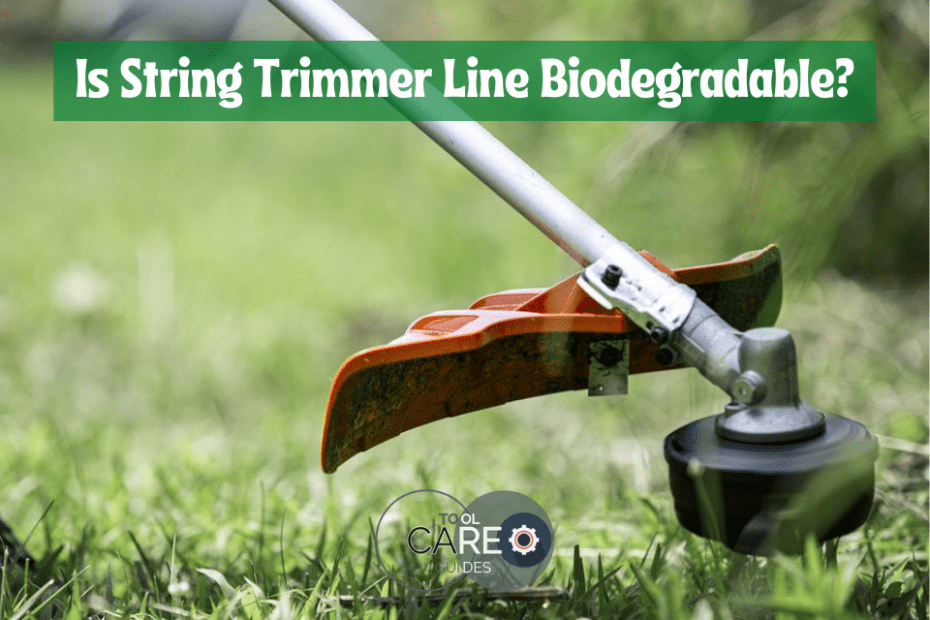Quick Overview of This Article
First of all, let’s enlighten ourselves. What are string trimmers? They are handy machines used to cut weeds and grass. For a traditional string trimmer line, its working mechanism involves the nylon line, a synthetic polymer whirring that revolves at high speed—as a result, trimming the weeds, shrubs, and grass.
Does a biodegradable line trimmer even exist? That’s a question you would probably ask yourself once you come across a line trimmer scattering tiny plastic pieces into your garden. Generally, most of the string trimmer line brands are not biodegradable; so far, only one biodegradable make is available in the market, as discussed below.
String trimmers are being produced widely in large quantities around the world. One 2004 article source states that almost 10 million trimmer lines are sold yearly. A company in China declares to manufacture 200 tons of string trimmer line in a month. Therefore, a major concern about plastic line trimmers is their inability to decompose. They can last up to 1000 years to decompose fully.
So, if you are conscious of the environment, it is necessary to consider the fact that the string trimmer you are using is environmentally friendly or not. This tool is specifically used by homeowners, landscapers, highway crews, and handy workers who chuck away weed, slash grass, and woody plants.
Therefore, let’s go through various aspects regarding the biodegradability of the string trimmer line. We will discuss in detail on features of line trimmers; these attributes include;
- Why is biodegradable string trimmer line significant?
- Biodegradable compared to traditional string trimmer line.
- Environmental effect of string trimmer line
- Are string trimmers unpleasant for the environment?
Why is Biodegradable String Trimmer Line Significant?
Probably, suppose you intend to use a string trimmer line, and you are environmentally conscious. In that case, it’s crucial to know that you might be contributing to the quantity of plastic polluting the environment. Therefore, one of the best solutions would be using a compostable line trimmer since plastic cannot be recycled, reused and threat to humanity & nature.
The tiny microplastics that break off the nylon line non-biodegradable trimmer have also made it difficult to notice them. Therefore, a biodegradable string trimmer line is of great importance because it is environmentally safe. With this, think about how our natural surroundings would be in safe hands once we all put the compostable trimmer line into practice.
With many string trimmer users worldwide, let’s expound on some of the main reasons biodegradable brands matter. These outstanding grounds are based on issues coming to light as a result of using non-biodegradable string trimmer lines, and they include;
- Just like any other plastic, the one on the trimmer line does not break down and will litter the earth, causing negative results to your surroundings. Most probably, that plastic will never decompose at all, even in many years to come.
- The trimmer line that breaks off as microplastic particles is of greater harm and injury to the birds, pets, and even other wildlife, mistaken for food particles.
- The string trimmer line tends to rub off as small plastic chunks due to friction, thus littering the environment broadly and all over without even being noticed. As a result, they accumulate in numerous places, unlike one plastic unit.
The Biodegradable String Trimmer Line Brand
Many brands are available, but only one brand is biodegradable, thus making them limited to the consumers. The string trimmer line that can decompose is the Bio trim made by Oregon. It’s essential to note that this brand is the fastest degrading among others available in the market.
Finally, to produce a 100% biodegradable brand, this achievement had to undergo various trial and error research experiments. As we advance, let’s take a look at the Bio trim brand that has proven to have the decomposing ability over time once it comes in contact with soil.
How Oregon’s Bio trim decomposition works
Bio trim’s trimmer line can take about 5 to 10 years to decompose fully. This time is positively an average period that will completely decay naturally, unlike the plastic string trimmer line. Therefore, this is how Bio trims biodegrade to attain environment-friendly features;
- As soon as they land on earth and touch the soil, they instantly begin to decompose. This kind of trimmer line consists of oxo-biodegradable substances for fast decomposition.
- Due to its ability to naturally decompose, microorganisms break them down by ingestion.
- Generally, the sunlight effect on the bio trim causes the breakage of the trim line’s constituents through the photo-oxidation process. Normally, this activity takes place after about three years.
- Thermal oxidation also contributes to breaking down of the Bio trim lines further.
Furthermore, the period they fully decompose depends on the surroundings’ climatic conditions. For example, in a warmer or sunnier climate, you should anticipate decomposition to take place rapidly.
Biodegradable vs Traditional String Trimmer Line
Our quest is to identify and analyze how microplastics that rub off from non-biodegradable trimmer lines impact the environment. We also have to differentiate between these two trimmer lines and clearly define each to establish their distinctive features.
When we compare these trimmer lines, the main highlights would be pros and cons. Thus, biodegradable brand comparison to the traditional standard string trimmer line includes their functionality, storage lifespan, availability in the market, their effect on your surroundings, and versatility of both string trimmers.
Functionality
They both have the quality functioning ability, but the traditional trimmer line is outstanding since it’s strong enough to hold out against any pressure of the job to be done. The biodegradable string trimmer may have a weak line, reducing its working ability over time. Comparing functionality may introduce other factors. For example, despite its cutting functionality, the Bio trim biodegradable brand reduces the noise produced by your trimmer tool.
Lifespan in Storage
Lifespan is the capability of the string trimmer to exist over a certain period; therefore, the biodegradable does not possess a prolonged lifespan when put in the store. It only lasts for a few years; hence you will have to utilize it within a specified period, unlike the traditional trimmer line, which lasts several decades until you decide to use it.
Availability in the Market
The biodegradable trimmer line is scarce and limited in the market. This scarcity has made it impossible for many consumers to acquire it. Contrary, the traditional trimmer line brand is readily and widely available in the market. For example, few brands that produce naturally-decomposable string trimmer lines are not offered extensively.
Effect on the Surroundings
This aspect is quite clear that the biodegradable brand of string trimmer holds up compared to the traditional brand. The traditional one negatively affects the environment due to its inability to decompose, thus littering the environment as it contributes to plastic pollution.
As much as both of these trimmer lines are available in the market, it will only depend on you as the consumer. Are you environmentally conscious? What do you think of the impact of traditional trimmer lines with plastic nylon? Additionally, stick with me as we will expound on this shortly.
Versatility
We point out how they both serve the consumers by talking about versatility, be it you or me. How do they appeal to you as a consumer or commercial enterprise? And therefore, in comparison, the traditional one is more versatile. This is due to its wide variety of production, thus appealing to the consumer. Furthermore, companies can avail it in various designs and styles, different diameters per the consumer’s demand, and its availability in several colors.
All this is evidence that the traditional brand outstands the biodegradable one despite both serving the same purpose to you as a consumer.
Environmental Effect of String Trimmer Line
Generally, trimmer lines have a great influence on our environment. Million tons of trimmer lines produced and sold is evident that they are broadly used worldwide. Food for thought, is their impact that massive? How do they play a part in our natural environmental setting? Is it positively or negatively?
Therefore, join me as we talk through the environmental impact of string trimmers. So far, you should agree that their effect mainly involves polluting the environment. To give you a clear perception of the consequences they bring about, let’s discuss the various pollution caused by these handy machines. Be it noise pollution, plastic pollution, air pollution, or even its interference to other organisms and their habitats within the environment.
Noise Pollution
Noise pollution is one of the first pollutions to note when operating a trimmer line. They tend to be a bit loud despite their powerful cutting performance. For example, the gas trimmer type largely amounts to noise pollution. Furthermore, string trimmers that have not been well greased, wearing out, and loose disconnection thus vibrating and rattling to cause discomfort when you’re operating it.
You can opt for the electric trimmer line to solve this since it produces minimal noise and works quietly, thus environmentally friendly.
Plastic Pollution
String trimmers drop tiny nylon microplastics into garden beds, yards, roadsides, fences, and golf courses almost every day. Therefore, these microplastics contribute to other plastic, resulting in plastic pollution affecting our today’s world. The major concern here is the one-time used plastic pieces that would easily go unnoticed until they accumulate and spread their pollution within the environment.
Statistics have shown that almost 80% of marine pollution is comprised of plastic, and further research though not clear, still indicates that trimmer line microplastics are largely found in the ocean.
Air pollution
As we look through this kind of pollution by string trimmer lines, the leading cause is the gas trimmer. This trimmer is very powerful and efficient in functionality. On the contrary, it emits fumes into the air. They are powered by fuel. Thus, a pollution agent, the gasoline vapor, can be inhaled by the operator and nearby people when released into the air.
The inhaled gasoline vapor can lead to lung problems, breathing difficulties, nose and throat discomfort. However, the solution to this problem will depend on how much you care about the environment. If you are concerned, you will have to opt for the electric trimmer line powered by electricity, thus environmentally friendly because no fumes are emitted.
Are String Trimmers unpleasant for the environment?
Genuinely, it would be yes, despite the work they can do they are bad to our environment. Finally, in this article, we will discuss how the string trimmers have negatively impacted organisms and their habitats within the environment.
Although not in all aspects of environmental effect, the Biodegradable brands of trimmer lines have made it quite easy for the environment to be sustainable.
Obstruction and Harm to the Organisms
This involves the harm caused by microplastics particles spewed by the synthetic nylon line on string trimmers as it trims grass, weeds, and shrubs. Suppose you are trimming on your garden or backyard. Your pets, domestic animals, or wild animals walking around may most likely mistake those tiny microplastics for food.
For example, once the particles are ingested, they can obstruct the digestive tract or hinder the excretory system roles. The same applies to the aqua animals poisoned by the plastic materials, which normally soak up other toxic pollutants.
For now, there is no way out for this problem since, by the time biodegradable string trimmer lines decay, they would have already caused harm to the organisms in our environment.
Destruction of the environmental Habitats
Over the years, String trimmer lines have been in use, and that’s obvious for you to understand their accumulation in the natural habitats is massive. This is one of the sensitive aspects that would clearly show that string trimmers are negatively influencing the environment.
Microplastics invade the habitats of organisms, with the greatest impact being in water bodies such as lakes and oceans. When they accumulate in water bodies, they interfere with the natural habitats of aqua animals and plants.
The string trimmers may be useful in trimming grass, weeds, and shrubs, but they have proven otherwise at greater heights due to long-term effects on our environment. The closest solution to this problem is a biodegradable trimmer line, despite taking quite a long period to decompose.
Thus, the biodegradable lines will decompose in fewer years. Therefore, it would not interfere with the natural surroundings.
Conclusion
As we wind up, it’s crucial to know that whether a string trimmer line is biodegradable or not, your environmental awareness matters the most. In general opinion, Bio trim is one of the few biodegradable trimmer lines that exist. But its availability has been overshadowed by the traditional string trimmer brand.
Despite the inability of biodegradable trimmer line variety to solve some pollution problems, they are at least the immediate solution. You should opt for a biodegradable brand, be it you as a consumer or commercial enterprise that produces string trimmer lines.
Resources:
https://www.condorferries.co.uk/plastic-in-the-ocean-statistics
https://www.oregonproducts.eu/site/products/biotrim/Biotrim_flyer_en.pdf
https://bestofmachinery.com/what-is-a-string-trimmer-for/




